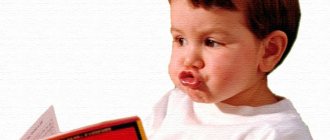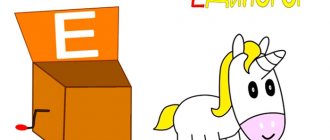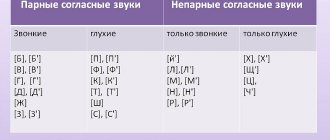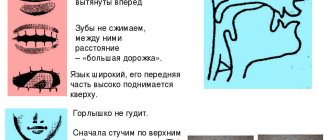Exercises for the development of the speech apparatus
When pronouncing the sound “sh” correctly, the tongue should occupy a certain position in the mouth. It is spread wide, and the tip is raised towards the hard palate, and forms a gap with it behind the upper teeth. The lateral edges of the tongue are pressed against the upper incisors.
How to teach a child to say the letter “sh” at home - do tongue exercises with him
If the baby cannot pronounce the sound correctly, articulation gymnastics is needed. For home exercises, special exercises are used that train the speech apparatus. The child should perform them in front of the mirror to see how he can repeat what his mother shows:
- “fence” - the baby must close his teeth and show his mother what kind of “fence” he has made;
- “tube” - the child stretches his lips forward like a tube, then quickly alternates between the “tube” and “fence” exercises;
- “lazy tongue” - the tongue needs to be stuck out of the mouth and placed on the lower lip, completely relaxed;
- “bucket” - we bend the relaxed tongue up and place it behind the upper teeth, blow on it, which produces the sound “sh”.
Tips for sound production [Ш]
Learning to pronounce a sound correctly is not so easy and therefore a child needs the support of adults. Every day you need to devote about 20 minutes to the lesson.
General recommendations
Before the lesson, the child must tune in. To do this, sit him in front of a mirror and remove toys from sight. In older preschool age, lesson time should be limited to 10-15 minutes.
Due to their age, children cannot sit in one place and therefore the lesson is kept short
You don't have to do one thing the whole time. You can develop articulation and breathing apparatus, fine motor skills, and speech hearing. All this is important for speech development.
Warm up for tongue and lips
In order to teach a child to speak correctly, his muscles must be prepared. For [Ш] you need to lift the sides and tip of the tongue. The lips are made round, but do not close completely.
Important! You can print out a visual illustration of the articulatory sound profile and review it with your child.
They begin to learn the exercises gradually. Approximate complex:
- With your mouth wide open, place your tongue outstretched on your lower lip.
- Raise the edges of the tongue so that they take the shape of a “cup”.
- Round your lips and hold in this position.
Additionally, you can do an exercise to develop breathing. A small piece of cotton wool is placed on the tip of the nose and the child must blow it upward.
Exercises to determine the position of a sound
In the preparatory group, the basics of sound analysis can be taught. This is a necessary skill for mastering reading and writing. To develop this skill, you will need sound symbols - they can be taken from Agranovich's manual.
You need to start the analysis with vowel sounds - aua, uau, oao, etc. To make it easier for the child to understand about the position, they make a picture of a bird or a car. The beginning is the first sound (the bird's head), the end is the last sound (the tail), everything in between is the middle (the body).
It is better to start teaching children with vowel syllables. Only upon successful completion of this stage do they move on to combination with a vowel. Later, you can use words, but you need to be careful about the correct selection (for example, “mushroom” sounds like “flu” and should not be confused with a preschooler).
Formation of sound culture of speech in children
Exercises to practice pronunciation
Parents do not always understand how to teach their child to say the letter Ш at home. After setting the sound, they immediately move on to automating it and for this they use direct syllables: SHA, SHO, SHU, SHI.
Then they move on to the reverse syllables: АШ, ОШ, УШ, ИШ.
Important! The child can lay out pebbles, wind threads and jump.
They move on to words and sentences only after it is possible to achieve the correct pronunciation of the sound [Ш] in syllables.
Tongue Twisters
For an introduction to independent speech, it is useful to pronounce tongue twisters during an individual speech therapy lesson on sound automation [Ш].
Tongue twisters start speaking slowly and gradually increase speed
Games with the letter Ш
After an individual lesson on making the sound [Ш], you can move on to memorizing the letter. To do this, the image is laid out from pebbles, plasticine, and counting sticks.
In preschool age, you can only write in block letters so as not to spoil your handwriting. Additionally, you can search for the letter Ш among the shaded pictures or select images that contain it.
Features of hissing sounds
Sibilants have their own characteristics when pronounced . So, you need to tighten your lips and move them forward a little. They cannot be pronounced with closed lips, unlike some others (for example, M). The tip of the tongue is slightly pressed against the palate with its edges, leaving a small space in the center of the tongue. It is through this that the air passes, creating a hissing sound when pronounced.
Initially, hissing consonants were soft in the Old Russian language. They appeared as a result of the first palatalization, or when the combination of consonants with [gj], ['zj] and other sounds changed.
The initial softness of these sounds determined the fact that in many literary monuments the letters that denoted them were pronounced followed by vowels or “ь” , for example:
- husband;
- nessshi;
- hour;
- comfort, etc.
However, in the process of the formation of linguistic norms and adverbs, [w] and [zh] hardened, but “ch” still remained soft. The hardening of [w] took place around the 14th century. At this time, variants of writing the sounds [w] or [zh] with the letter “s” after them appeared in literary monuments. For example, “Shyshkin” or “hold.”
In modern language, it is traditional to write a soft sign at the end or the letter “and” to indicate the sound [s] in words such as:
- disturb;
- sew;
- fat;
- rye, etc.
Combinations such as soft [schtsch] or [zhj], which were common in antiquity, then lost the explosive element in such combinations in words such as “I’m looking for” or “yeast.”
Sample tasks on the topic of sibilant consonants
A teacher who will conduct a lesson for first-graders on this topic should set himself the following tasks:
- he is obliged to create conditions for children to learn the concept of hardness and softness of consonants, for example, that “zh” and “w” are always hard;
- teach students to correctly formulate writing skills;
- develop their written and coherent oral speech;
- use new information technologies when teaching.
After the teacher explains the essence of the lesson, he can write several letters on the board (B, L, CH, K, R).
Then the question is asked which of the letters presented does not denote any sound, and the correct answer is b. You can also ask students to find the letter for the hissing sound.
Next, we suggest working with a textbook of the following nature:
- children are asked to take turns reading the text (the skill of reading aloud is improved);
- we select some words and invite the children to explain their meaning (at the teacher’s choice);
- offer to find those words that contain letters denoting hissing consonants;
- Have them say them out loud and write the letters on the board.
The next part of the lesson is to work with images . Hang pictures on the board and ask students questions:
- what objects are shown in the pictures;
- what names contain hissing sounds;
- Which of the listed sizzlers are hard and which are soft.
The child does not pronounce the sound [Ш]
A group of hissing sounds steadily enters speech by the age of four. Until this time, absence or distortion is considered a conditional norm. Parents may not always notice that something is wrong.
Classes can be conducted either with a speech therapist or at home
Pronunciation assessment
Pronunciation of any sound may be incorrect. In this case, the simplest option is the absence of the sound [Ш]. Then the child’s speech will sound something like this: apka, ina, maina, etc.
Sound distortion is more common. With buccal pronunciation, the air does not pass through the tongue and lips, but goes into the cheeks. The result is a dull noise at the output. You can visually see how the child’s cheeks are puffed up.
Sometimes a child can pronounce sibilants in the “down” position. In this case, it is not the tip of the tongue that approaches the hard palate, but the middle part of its back. In this case, you get something similar to [Ш].
If the baby manages to pronounce [Ш] the back part of the tongue, which approaches the hard palate. At the exit you can hear something resembling a fricative [X] or a voiced southern Russian [G].
Important! Only a speech therapist can accurately identify the violation.
When a child learns to speak, he can replace one sound with another. Often the hissing group is replaced by whistling ones - up to four years - this is the physiological norm.
If there are problems, the preschooler begins to change [W] to [S]. In this case, instead of “hat” he says “sapka”, instead of “machine” he says “masina”.
Physiological factors
A child can be easily talked into, but he does not always pronounce all the sounds correctly. With sibilants, problems can arise due to a shortened hyoid ligament.
Sometimes problems arise due to enlarged adenoids. In this case, the preschooler has breathing problems.
In severe cases, the child cannot breathe through his nose at all and opens his mouth slightly
A baby may pronounce sounds incorrectly due to minimal brain dysfunction. In this case, there are problems with raising the tip of the tongue, and switching from pose to pose is difficult.
When to contact a speech therapist
You can work with children at home in case of mild disorders. For example, if there are no problems with the dictionary and lexico-grammatical structure of speech. In this case, parents can perform articulation and breathing exercises.
The help of a speech therapist is required in case of general speech underdevelopment and dysarthria. With such violations, there are no quick ways to correct sound pronunciation.
It is easy to identify such problems. When first diagnosed, the child has a poor vocabulary; he may connect words incorrectly and have difficulty forming words.
Lesson on speech development in the preparatory group
With dysarthria, muscle innervation is disrupted. In this case, it is difficult for the preschooler to pronounce similar sounds, his breathing is weak and he has hypertonicity or hypotonicity of the muscles of the articulatory apparatus.
Important! For any problem, parents are direct participants in the correction process.
With dysarthria and general underdevelopment of speech, not only pedagogical help is needed, but also medical help.
Working with tongue twisters
Tongue twisters are an excellent warm-up for children , which perfectly develops their speech skills. In the educational process they are used in different ways, in particular, in the study of sibilant consonants.
Invite students to read aloud several tongue twisters in a row. Moreover, the first time this must be done slowly, and then gradually increase the rate of pronunciation.
Ask the children what hissing sounds they found in tongue twisters, whether they differ from each other, and what their main characteristics are.
While taking dictation , offer to write down one of them in your notebook and ask students to underline the hard (or soft) sibilants. Invite one of the students to do this at the board.
Partial written work was mentioned above. It can also include homework. Sometimes workbooks contain tasks where you need to insert missing letters into words that contain certain sibilants. They should be emphasized.
So, we looked at what hissing consonant sounds are, how they can be identified, and with the help of what tasks you can teach a lesson at school on this topic.
Pronunciation check
Parents can check the correct pronunciation of sounds by their child themselves.
There are different tests for this. You can use the same technique with which speech therapists evaluate a child’s speech at the first appointment: ask to pronounce words or syllables containing hissing sounds (for example, noise, school, came, bumblebee). To pronounce W correctly, the tongue should be like a ladle, located in the center of the oral cavity, and not stick out forward. It is important that the tip points upward.
The verification should be carried out in stages:
- The first stage is a general check. You need to ask the child to say a couple of easy sentences that contain words with a letter (for example, “you should wear a scarf in winter,” “the cat caught the mouse”). Next, you need to move on to the pronunciation of individual words (edge, hat, good, porridge);
- the second stage is checking the sound of Ш in isolation. Attention is paid to syllables. You need to ask the baby to say “OSH”, “SHA”, “OSHO”, “USHU”. This will allow you to find out how well the child can pronounce sounds. It happens that such a check reveals problems with vowel sounds. Therefore, it is recommended to vary the syllables;
- the third stage is testing in individual syllables with voiceless and voiced consonants.
To check the pronunciation of different sounds, there are special cards with bright pictures. They are sold in children's stores. Thanks to such cards, the test can be carried out in the form of an enjoyable game.








